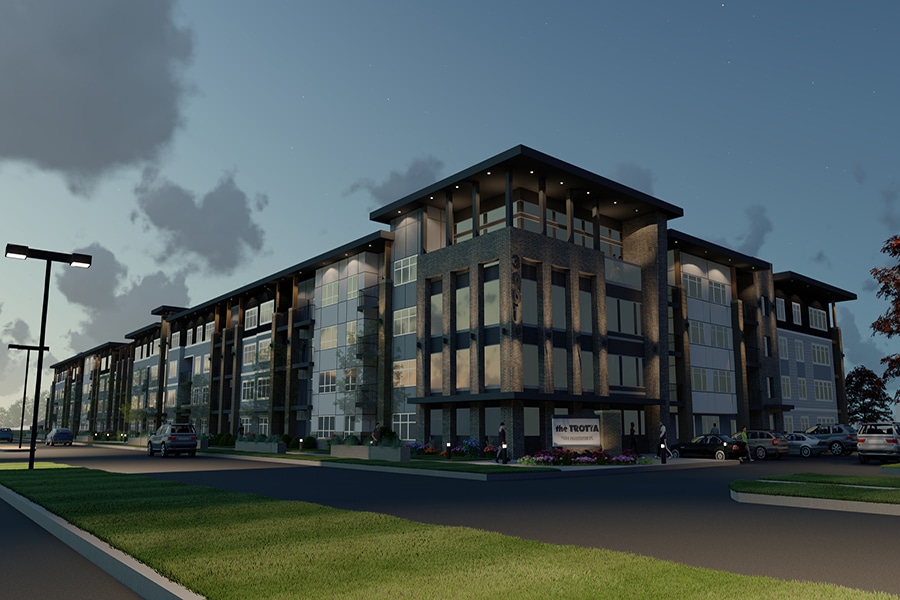Multifamily Housing Forecast: Amenities Trends for 2021
ramaker insights
Multifamily Housing Forecast: Amenities Trends for 2021
adapting plans to meet the needs of end-users
First gyms and ground-level commercial spaces closed. Then they reopened at reduced capacities. Then, in some cases, they closed again.
The COVID-19 pandemic forced architects and developers across the country to consistently revise their approaches to amenities for multifamily developments. As restaurants took over parklets and built makeshift dining huts in attempts to stay open, developers shifted their focus to in-unit amenities.
Better Wi-Fi replaced shared business centers. New washers and dryers made up for shuttered laundry facilities. The list goes on.
After adopting an agile approach for more than a year, it’s difficult for some developers to gauge current end-user expectations. As vaccination rates increase and residents begin to gather safely indoors and outdoors, which amenities should developers prioritize?
This question seemed to dominate The 2021 Jersey City Summit for Real Estate Investment. Ramaker’s Northeast Business Development Team attended the event, which covered some of the most pressing topics in multifamily real estate. Despite the variety of engaging panels and distinguished speakers, many of the conversations shared a common thread: residents’ expectations for specific amenities after the pandemic.
Here’s why. The way both end-users and developers think about amenities has changed. Amenities that may have been viewed as luxuries before the COVID-19 pandemic are now considered absolute necessities.
Take, for example, home offices. According to the 2021 Microsoft Work Trend Index, 73% of employees want to take advantage of flexible remote work options moving forward. As workplaces and employee behaviors change, so do employees’ requirements for dedicated office space in their apartments and homes.
Home office space is just one of many trending amenities. How can architects and developers adapt existing plans to meet the evolving needs of end-users?
In this post, we’ll present some of our key takeaways for The Jersey City Summit and consider current and emerging trends for multifamily developments. We’ll also share some of the most efficient ways to incorporate necessary amenities and add value for residents.
Focusing on amenities in multifamily units
As the pandemic raged across the globe, developers and property managers began to prioritize in-unit amenities over shared ones. With fitness centers, pools, and café areas temporarily closed (or operating at reduced capacities), attention turned to improvements like providing better Wi-Fi and upgrading appliances. Individual balconies, for a time, became non-negotiable for developments in progress.
As many residents continue to work from home, and as many parents opt to move forward with remote learning for their children, the emphasis on high-quality amenities in individual units remains.
According to Cassie O’Connor, Ramaker’s Northeast Business Development Lead, developers should direct their attention to fresh air: “Access to a safe and healthy living space is not a luxury, it is a necessity. During this unprecedented pandemic, the importance of fresh and filtered air rose to the forefront,” says O’Connor.
“The most cost-effective approach is the addition of an energy recovery ventilator (ERV). Other options include adding small balconies directly off units or utilizing a building’s roof for individual private terraces. With these additions, we can help provide the healthy environment everyone deserves.”
While having fresh and filtered air has become increasingly important, space is still top of mind for end-users. There’s no way around it: People want larger units.
This call for more space presents new challenges for firms that are currently developing multifamily properties. How can developers meet the needs of future residents while maintaining the originally proposed square footage?
One popular solution is incorporating alcove spaces—or nooks—near unit entrances. As small solutions to a big demand, alcoves provide more usable space without completely disrupting original plans. From study spaces to mudrooms, end-users can transform nooks to meet their needs.
Alcoves add flexibility for residents and developers. By providing a combination of units with alcoves and ones without them, developers can present more options to potential residents, allowing end-users to choose the option best-suited to their current lifestyles.
“Access to a safe and healthy living space is not a luxury, it is a necessity.”
—Cassie O’Connor, Ramaker’s Northeast Business Development Lead
Adapting to new work habits
Remote work isn’t going anywhere. But does remote work have to mean working from home? This question lies at the center of Cal Newport’s recent New Yorker article. Newport’s proposal: Businesses and organizations should encourage work from near home options for their employees by providing professional spaces close to (but separate from) their living spaces.
Newport’s suggestion is by no means novel. “Third workplaces” are popping up across the country, and real estate developers have already begun to include co-working spaces into multifamily housing plans, giving residents a viable escape from the distractions of home without having to commute to their offices. It’s no surprise that co-working spaces are currently one of the most popular amenities for multifamily developments.
For architects and developers, variety is key when designing and building flexible work hubs. Consider large communal tables with access to power and ample seating, reservable meeting rooms for individual use and video conferencing, and telephone booth spaces for private calls. Incorporating open lounges with comfortable seating for impromptu meetings should also be a priority. By offering a range of workspaces and technology, residential co-working spaces can cater to various work styles.
Connecting residents to their communities
After a period of prolonged separation from friends, family, and communities, many residents are ready to revitalize their connections to the places they live. While developers should still pay attention to in-unit amenities, residents also need spaces to gather, socialize, and enjoy themselves.
The popularity of outdoor dining soared during the pandemic. Don’t expect that to change—especially in the northeast. As residents continue to seek out al fresco dining options, developers need to reconsider their ground-level amenities.
To maintain a sense of community, the ground floor of multifamily buildings should balance dining and retail options with shared spaces. Access to commercial storefronts matters, but developers should blend bars, restaurants, and shops with parklets and ground-level units with street access to create a neighborhood feel.
Designing multifamily housing in New Jersey and across the country
A multidiscipline architecture and engineering firm with offices in New Jersey and across the country, Ramaker has the capabilities and reach to serve as a one-stop shop for multifamily housing projects throughout the northeast.
Our architectural, engineering, and interiors teams design multifamily living environments that bridge the gap between housing and home, connecting residents to their communities—and each other. Planning a new development? We’d love to talk to you about it.
key contact

CASSIE O’CONNOR
Cassie joined the Ramaker team in June of 2021, with prior experience in various markets from custom single-family housing to affordable housing, as well as retail and hospitality. With a background in interiors as well, she is well-versed in current trends and transitional design that stands the test of time.
Cassie is from the Tri-State (NY, NJ, CT) area and has spent the last decade working and living in New York City. She is now located in the Hudson Valley, just 50 miles north of Manhattan, and serves as Ramaker’s Northeast Business Development Lead.





